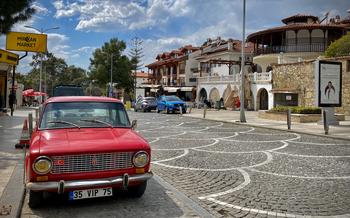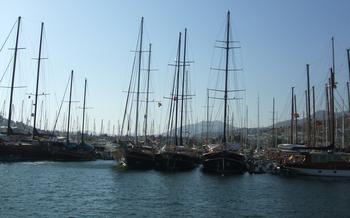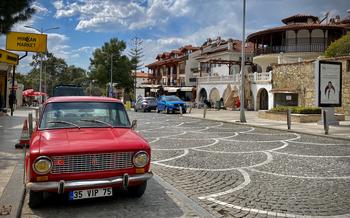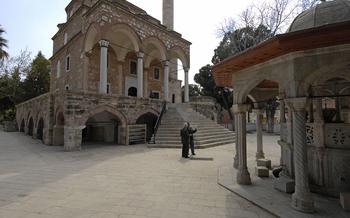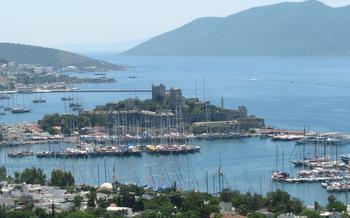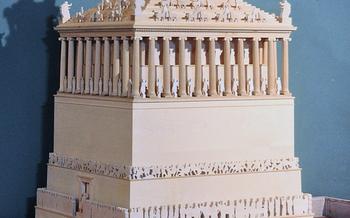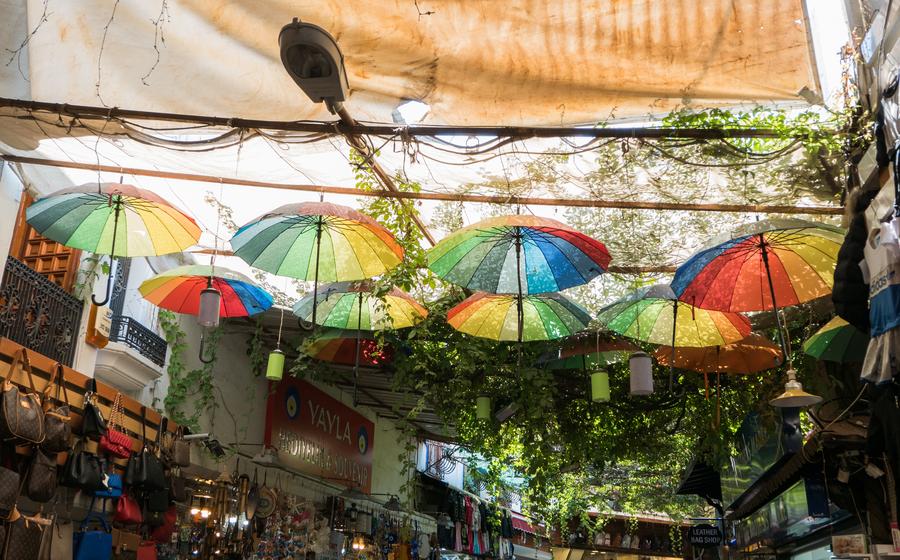
Bodrum Amphitheatre
- Historical Significance:
- Architectural Features:
- Seating and Capacity
- Gladiatorial Contests
- Theatrical Performances
- Religious Ceremonies:
- Public Gatherings
- Restoration and Preservation
- Visiting the Bodrum Amphitheatre
- Events and Performances
- Local Legends and Folklore
- Photography Tips:
- Nearby Attractions:
- Accessibility for Disabled Visitors
- Insider Tip:
Historical Significance:
The Bodrum Amphitheatre, nestled in the heart of Bodrum, Turkey, holds immense historical significance as a testament to the region's rich ancient heritage. Constructed during the Hellenistic period, likely in the 4th century BC, it served as a vibrant venue for theatrical performances, gladiatorial contests, and religious ceremonies. Its strategic location, overlooking the picturesque Bodrum Harbor, made it a focal point for entertainment and public gatherings in the ancient city of Halicarnassus.
Despite its abandonment after the 4th century AD, the amphitheatre's remarkable resilience has allowed it to stand the test of time. Rediscovered in the 1970s, it underwent extensive restoration efforts to preserve its original features and grandeur. Today, it stands as one of the best-preserved amphitheatres in Turkey, inviting visitors to step back in time and experience the echoes of ancient civilizations.
Architectural Features:
The Bodrum Amphitheatre boasts impressive architectural features that showcase the engineering prowess of ancient civilizations. Constructed using local stone and marble, the amphitheatre exhibits a semi-circular seating arrangement that allows for optimal viewing of performances and events. The stage building, known as the skene, is a marvel of ancient architecture, featuring elaborate decorations and intricate carvings that depict scenes from mythology and history. The amphitheatre's restoration efforts have been meticulous, aiming to preserve its original features while ensuring its structural integrity for future generations. These efforts have successfully maintained the amphitheatre's grandeur and authenticity, allowing visitors to immerse themselves in the architectural wonders of the ancient world.
Seating and Capacity
The Bodrum Amphitheatre, with its impressive dimensions, could accommodate up to 13,000 spectators, making it one of the largest ancient theatres in Anatolia. The seating arrangement followed the typical Greek and Roman style, with semi-circular tiers of seats rising from the orchestra. These tiers were divided into several sections, reflecting the social hierarchy of the ancient world.
The lower rows, closest to the stage, were reserved for the elite and privileged classes, including government officials, wealthy citizens, and honoured guests. These seats, often referred to as the "proedria," were typically made of marble or limestone and provided the best views of the performances.
The middle tiers were occupied by the middle class, consisting of merchants, artisans, and traders. These seats were usually made of stone or wood and offered a comfortable viewing experience.
The upper tiers, located at the back of the amphitheatre, were designated for the lower classes and slaves. These seats were often made of simple wooden benches or standing room and provided a limited view of the stage.
The seating arrangement at the Bodrum Amphitheatre reflects the social hierarchy prevalent in ancient society, where class and status determined one's position and privileges within the theatre.
Gladiatorial Contests
In ancient Rome, gladiatorial contests were a popular form of entertainment, and the Bodrum Amphitheatre was no exception. These contests showcased the skills and courage of specially trained gladiators, who fought each other to the death or until one surrendered. The gladiators came from various backgrounds, including slaves, criminals, and even volunteers, and they underwent rigorous training to prepare for these deadly encounters.
The rules and regulations governing gladiatorial fights were complex and varied depending on the type of contest. Some fights were one-on-one duels, while others involved multiple gladiators fighting simultaneously. The gladiators were armed with a variety of weapons, including swords, spears, shields, and nets, and they often wore protective armor.
The ethical debates surrounding gladiatorial contests were intense, with many people questioning the morality of such violent spectacles. The contests were eventually banned in the 5th century AD due to the influence of Christianity, which condemned them as barbaric and inhumane. Despite their controversial nature, gladiatorial contests remain a fascinating aspect of ancient Roman history, and the Bodrum Amphitheatre stands as a testament to this unique and brutal form of entertainment.
Theatrical Performances
The Bodrum Amphitheatre was not only a venue for gladiatorial contests but also a vibrant center for theatrical performances. In ancient Greek and Roman culture, theatre held a significant place, serving as a means of entertainment, education, and social commentary.
The amphitheatre's stage building, with its elaborate decorations and intricate architectural details, provided a grand setting for theatrical productions. Plays, comedies, and musical events brought the community together, fostering a shared cultural experience.
The acoustics of the amphitheatre were carefully designed to enhance the audience's enjoyment of the performances. The semi-circular seating arrangement ensured that sound carried clearly to every spectator, creating an immersive and engaging atmosphere.
The plays performed at the Bodrum Amphitheatre covered a wide range of genres, from tragedies and comedies to satires and farces. These performances offered social commentary, explored human emotions, and provided a platform for artistic expression.
Attending a theatrical performance at the Bodrum Amphitheatre was a significant social event for the ancient Bodrum community. It was an opportunity to come together, share stories, and celebrate the power of the performing arts.
Religious Ceremonies:
The Bodrum Amphitheatre played a significant role in the religious life of ancient Bodrum. It served as a sacred space for various religious ceremonies and festivals that were an integral part of the community's cultural and spiritual identity. These ceremonies were deeply rooted in ancient Greek and Roman religious traditions and held great importance for the people of the city.
The amphitheatre's unique architecture and design created an awe-inspiring setting for religious rituals and sacrifices. The circular shape symbolized the unity and wholeness of the community, while the elevated stage provided a focal point for the ceremonies. The elaborate decorations and sculptures that adorned the stage and seating areas depicted mythological scenes and deities, creating a sacred atmosphere that enhanced the spiritual experience of the participants.
Some of the most notable religious ceremonies held at the Bodrum Amphitheatre included sacrifices to honor specific deities, such as Zeus, Apollo, and Artemis. These rituals involved the offering of animals, libations, and prayers to appease the gods and seek their blessings. The amphitheatre's acoustics played a crucial role in amplifying the prayers and chants of the participants, creating a powerful and immersive spiritual experience.
Religious festivals were also celebrated at the amphitheatre, bringing the community together to honor their gods and celebrate their shared beliefs. These festivals often featured processions, musical performances, and theatrical reenactments of mythological stories. The amphitheatre's spacious seating arrangement allowed for large crowds to gather and participate in these joyous celebrations, fostering a sense of unity and communal belonging.
The religious significance of the Bodrum Amphitheatre extended beyond the physical space itself. It served as a symbol of the city's devotion and reverence for the divine. The ceremonies and festivals held within its walls reinforced the spiritual bonds that united the community and shaped their cultural identity. To this day, the amphitheatre stands as a testament to the deep religious traditions that were an integral part of ancient Bodrum's society.
Public Gatherings
The Bodrum Amphitheatre, with its impressive size and central location, served as a crucial venue for public gatherings in ancient Bodrum. These gatherings played a vital role in the functioning of the city's democracy, allowing citizens to participate in decision-making processes and stay informed about important matters.
Political rallies, where candidates presented their platforms and sought support for their campaigns, were frequently held within the amphitheatre's walls. Assemblies, where citizens discussed and voted on laws and policies, were also common occurrences. Additionally, proclamations and announcements of important news or events were made at the amphitheatre, ensuring that the entire community was well-informed.
The amphitheatre's capacity to accommodate a large number of people made it an ideal location for these public gatherings. The seating arrangement, with its distinct sections, reflected the social hierarchy of the city, with VIP boxes reserved for officials and dignitaries, while the general seating areas accommodated the rest of the population.
The amphitheatre's acoustics, designed to carry voices throughout the space, facilitated effective communication during these gatherings. Citizens could clearly hear the speakers, ensuring their active participation in the discussions and decision-making processes that shaped the city's destiny.
The Bodrum Amphitheatre, with its impressive size, strategic location, and excellent acoustics, served as a central meeting place for the community, fostering civic engagement and contributing to the functioning of ancient Bodrum's democracy.
Restoration and Preservation
As a testament to its enduring legacy, the Bodrum Amphitheatre underwent a comprehensive restoration project in the 1970s, restoring its grandeur and preserving its historical integrity. This meticulous undertaking involved meticulous attention to detail, using traditional construction techniques and materials to maintain its original character.
The restoration process focused on stabilizing the amphitheatre's structure, repairing damaged seating tiers, and reconstructing portions that had been lost over time. The team of experts employed local stone and marble, mirroring the materials used in its initial construction, to ensure authenticity and cohesion.
The restoration efforts extended beyond structural repairs, encompassing the intricate carvings and decorative elements that adorn the stage building. Skilled artisans painstakingly restored these embellishments, bringing the amphitheatre's rich ornamentation back to life.
The Bodrum Amphitheatre stands today as a remarkable example of successful restoration, a testament to the dedication and expertise of the preservationists who ensured its legacy for generations to come. Ongoing conservation projects aim to protect and maintain this historical treasure, ensuring that visitors can continue to marvel at its grandeur for years to come.
Visiting the Bodrum Amphitheatre
Located in the heart of Bodrum, the Bodrum Amphitheatre is easily accessible by foot or public transportation. For those arriving by car, there are several parking lots nearby. The amphitheatre is open to the public daily, with extended hours during the summer months. To avoid the crowds and enjoy a more immersive experience, it is recommended to visit early in the morning or late in the afternoon.
The Bodrum Amphitheatre offers a range of visitor facilities to enhance the experience. Guided tours are available in multiple languages, providing visitors with a deeper understanding of the amphitheatre's history, architecture, and significance. Audio guides are also available for self-guided tours. For those interested in purchasing souvenirs, there is a gift shop on-site.
The Bodrum Amphitheatre is fully accessible for visitors with disabilities. Wheelchair-accessible ramps allow easy access to the seating areas, and designated seating areas are available for those with limited mobility. Audio guides for the visually impaired are also provided. The amphitheatre's management is committed to ensuring that all visitors can enjoy the historical and cultural significance of this iconic landmark.
Events and Performances
The Bodrum Amphitheatre is not only a historical monument but also a vibrant venue for cultural events and performances that bring the ancient world to life. Throughout the year, the amphitheatre hosts a variety of events that showcase the best of Turkish and international talent.
The highlight of the amphitheatre's cultural calendar is the Bodrum International Ballet Festival, which takes place every summer. This prestigious festival attracts renowned ballet companies from around the world, who perform classical and contemporary ballet masterpieces in the amphitheatre's enchanting setting.
In addition to ballet, the amphitheatre also hosts a range of other cultural events, including concerts, plays, and exhibitions. These events provide a unique opportunity to experience the amphitheatre's ancient atmosphere while enjoying the talents of contemporary artists.
Attending an event at the Bodrum Amphitheatre is a truly special experience that allows visitors to immerse themselves in the history and culture of this ancient city. Whether you are a fan of ballet, theatre, or music, there is something for everyone at the Bodrum Amphitheatre.
Here are some practical tips for attending an event at the Bodrum Amphitheatre:
- Book your tickets in advance, especially for popular events, to avoid disappointment.
- Arrive early to secure a good seat and enjoy the amphitheatre's atmosphere before the show begins.
- Bring a cushion or blanket to sit on, as the stone seats can be uncomfortable for long periods.
- Dress appropriately for the weather, as the amphitheatre is mostly exposed to the elements.
- Enjoy the performance and the unique experience of seeing a show in this ancient setting.
Local Legends and Folklore
The Bodrum Amphitheatre is steeped in local legends and folklore that have been passed down through generations, adding to its mystique and allure. One popular legend tells the tale of a brave gladiator who fought valiantly in the arena, earning the respect and admiration of the crowd. Upon his victory, he was granted his freedom and became a local hero, his name forever etched in the annals of Bodrum's history.
Another captivating legend revolves around the amphitheatre's underground chambers, said to be haunted by the restless spirits of gladiators who perished within its walls. Visitors who dare to venture into these dark and eerie chambers may catch a glimpse of these spectral figures, their ghostly cries echoing through the ancient corridors.
Stories of hidden treasures buried beneath the amphitheatre have also captured the imagination of many. Some believe that valuable artifacts from ancient civilizations lie concealed within its depths, waiting to be discovered by a lucky adventurer. These tales of lost treasures have fueled the dreams of fortune seekers and treasure hunters alike, adding to the amphitheatre's allure as a place of mystery and wonder.
Preserving and passing down these local legends and folklore is of utmost importance, as they form an integral part of the Bodrum Amphitheatre's rich cultural heritage. They breathe life into the ancient stones, connecting visitors to the past and allowing them to experience the amphitheatre's history in a deeper and more meaningful way.
Photography Tips:
Capturing the essence of the Bodrum Amphitheatre through photography requires skill and attention to detail. Here are some tips to help you capture stunning photographs of this ancient wonder:
-
Choose the Right Angle: The amphitheatre's imposing structure demands a wide-angle lens to capture its grandeur. Experiment with different angles to find the perfect perspective that showcases its scale and majesty.
-
Master the Lighting: The best time to photograph the amphitheatre is during the golden hours of sunrise and sunset. The warm, diffused light casts a magical glow on the ancient stones, creating a captivating atmosphere.
-
Utilize a Tripod: To ensure sharp and steady shots, especially in low-light conditions, use a sturdy tripod. This will minimize camera shake and allow you to capture crisp details.
-
Experiment with Composition: Play with foreground elements like trees or columns to add depth and interest to your composition. Incorporate the surrounding landscape to create a sense of place and convey the amphitheatre's historical significance.
Nearby Attractions:
In addition to the captivating allure of the Bodrum Amphitheatre, the enchanting town of Bodrum offers a diverse array of attractions that will captivate the hearts and minds of discerning travelers. A stone's throw away from the amphitheatre lies the majestic Bodrum Castle, a formidable fortress that has stood sentinel over the turquoise waters of the Aegean Sea for centuries. Delve into its intriguing history as you wander through its labyrinthine chambers and ascend its ramparts to savor breathtaking panoramic vistas.
A short stroll from the amphitheatre and the castle, discover the Mausoleum at Halicarnassus, one of the Seven Wonders of the Ancient World. Marvel at the remnants of this awe-inspiring mausoleum, once a magnificent tribute to the life of Mausolus, satrap of Caria. Its grandeur, though diminished by the ravages of time, still evokes a sense of wonder and admiration.
For those captivated by the depths of the sea and its hidden treasures, the Bodrum Museum of Underwater Archaeology beckons. Journey through the fascinating world of marine archaeology as you explore a treasure trove of artifacts retrieved from the depths of the Aegean Sea. Discover ancient shipwrecks, exquisite pottery, and sculptures that paint a vivid picture of maritime life in bygone eras.
These attractions, each possessing its own unique charm and historical significance, are conveniently located in close proximity to the Bodrum Amphitheatre, allowing visitors to craft an itinerary that seamlessly blends history, culture, and natural beauty.
Accessibility for Disabled Visitors
The Bodrum Amphitheatre is committed to ensuring that all visitors, including those with disabilities, can fully enjoy its historical and cultural significance. Wheelchair-accessible ramps have been installed throughout the amphitheatre, allowing visitors with limited mobility to easily navigate the site. Designated seating areas are also available for visitors with disabilities, offering unobstructed views of the stage and performances.
For visitors with visual impairments, audio guides are available in multiple languages, providing detailed descriptions of the amphitheatre's history, architecture, and ongoing events. The amphitheatre staff is also trained to assist visitors with disabilities, ensuring that they have a safe and enjoyable experience. Visitors with specific accessibility needs are encouraged to contact the amphitheatre's management in advance to make arrangements for assistance.
By providing these accessibility features, the Bodrum Amphitheatre demonstrates its commitment to inclusivity and ensures that everyone can experience the wonders of this ancient landmark.
Insider Tip:
For an unforgettable experience, plan your visit to the Bodrum Amphitheatre during the sunset hours. As the sun dips below the horizon, the amphitheatre's ancient stones are bathed in a warm, golden glow, creating a magical and ethereal atmosphere. Take advantage of this opportunity to capture stunning photographs and immerse yourself in the amphitheatre's rich history. Additionally, consider bringing a flashlight or headlamp to explore the amphitheatre's underground chambers, which offer a unique perspective on its construction and use. Guided tours in multiple languages are available for a more in-depth understanding of the amphitheatre's history and significance. These tours provide fascinating insights into the lives of gladiators, actors, and the ancient audiences who once filled these seats.

